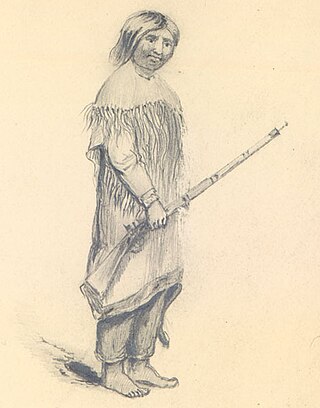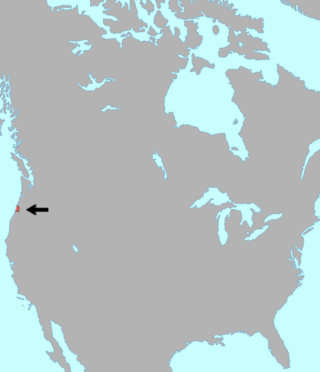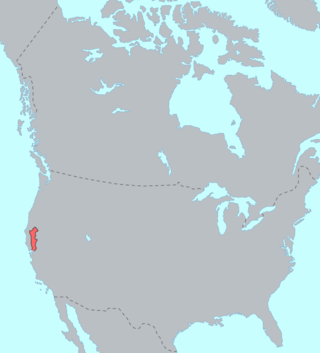Related Research Articles
Siuslaw is one of the tribes comprising the Confederated Tribes of Siletz Indians and a portion of the off-reservation population forms part of the three Confederated Tribes of Coos, Lower Umpqua and Siuslaw Indians located on the southwest Oregon Pacific coast in the United States. Lower Umpqua and Siuslaw are closely related peoples, both of whom spoke dialects of Siuslaw language, a Coast Oregon Penutian language. The Siuslaw language is extinct.
Coos people are an indigenous people of the Northwest Plateau, living in Oregon. They live on the southwest Oregon Pacific coast. Today, Coos people are enrolled in the following federally recognized tribes:

The Umpqua people are an umbrella group of several distinct tribal entities of Native Americans of the Umpqua Basin in present-day south central Oregon in the United States. The area south of Roseburg is now known as the Umpqua Valley.

Penutian is a proposed grouping of language families that includes many Native American languages of western North America, predominantly spoken at one time in British Columbia, Washington, Oregon, and California. The existence of a Penutian stock or phylum has been the subject of debate among specialists. Even the unity of some of its component families has been disputed. Some of the problems in the comparative study of languages within the phylum are the result of their early extinction and limited documentation.
The Siletz were the southernmost of several divisions of the Tillamook people speaking a distinct dialect; the other dialect-divisions were: Salmon River on the Salmon River, Nestucca on Little Nestucca River, Nestucca River and Nestucca Bay, Tillamook Bay on the Tillamook Bay and the mouths of the Kilchis, Wilson, Trask and Tillamook rivers, and Nehalem on Nehalem River. The name "Siletz" comes from the name of the Siletz River on which they live. The origin of the name is unknown
Oregon Penutian is a hypothetical language family in the Penutian language phylum comprising languages spoken at one time by several groups of Native Americans in present-day western Oregon and western Washington in the United States. Various languages in the family are divided by dialects that are in most cases identical to the various identified tribal bands in the region.
The Alsea are a Native American tribe of Western Oregon. They are, confederated with other Tribes on the Siletz Reservation, Oregon, and are members of the Confederated Tribes of Siletz.

The Coosan language family consists of two languages spoken along the southern Oregon coast. Both languages are now extinct.

The Confederated Tribes of the Coos, Lower Umpqua and Siuslaw Indians of Oregon are a federally recognized Native American tribe of Hanis Coos, Miluk Coos, Lower Umpqua, and Siuslaw people in Oregon.

Alsea or Alsean was two closely related speech varieties spoken along the central Oregon coast until the early 1950s. They are sometimes taken to be different languages, but it is difficult to be sure given the poor state of attestation; Mithun believes they were probably dialects of a single language.

Wintuan is a family of languages spoken in the Sacramento Valley of central Northern California.

Kalapuyan is a small extinct language family that was spoken in the Willamette Valley of Western Oregon, United States. It consists of three languages.

The Tsimshianic languages are a family of languages spoken in northwestern British Columbia and in Southeast Alaska on Annette Island and Ketchikan. All Tsimshianic languages are endangered, some with only around 400 speakers. Only around 2,170 people of the ethnic Tsimshian population in Canada still speak a Tsimshian language; about 50 of the 1,300 Tsimshian people living in Alaska still speak Coast Tsimshian. Tsimshianic languages are considered by most linguists to be an independent language family, with four main languages: Coast Tsimshian, Southern Tsimshian, Nisg̱a’a, and Gitksan.
The Confederated Tribes of Siletz Indians in the United States is a federally recognized confederation of more than 27 Native American tribes and bands who once inhabited an extensive homeland of more than 20 million acres from northern California to southwest Washington and between the summit of the Cascades and the Pacific Ocean. After the Rogue River Wars, these tribes were removed to the Coast Indian Reservation, now known as the Siletz Reservation. The tribes spoke at least 11 distinct languages, including Tillamook, Shasta, Lower Chinook, Kalapuya, Takelma, Alsea-Yaquina, Siuslaw/Lower Umpqua, Coos, the Plateau Penutian languages Molala and Klickitat, and several related Oregon Athabaskan languages.
Leo Joachim Frachtenberg was an anthropologist who studied Native American languages. Frachtenberg helped write the Handbook of American Indian Languages, BAE Bulletin 40, and also wrote "Alsea Texts and Myths", BAE Bulletin 67.

The history of steamboats on the Oregon Coast begins in the late 19th century. Before the development of modern road and rail networks, transportation on the coast of Oregon was largely water-borne. This article focuses on inland steamboats and similar craft operating in, from south to north on the coast: Rogue River, Coquille River, Coos Bay, Umpqua River, Siuslaw Bay, Yaquina Bay, Siletz River, and Tillamook Bay. The boats were all very small, nothing like the big sternwheelers and propeller boats that ran on the Columbia River or Puget Sound. There were many of them, however, and they came to be known as the "mosquito fleet."

Siuslaw was the language of the Siuslaw people and Lower Umpqua (Kuitsh) people of Oregon. It is also known as Lower Umpqua. The Siuslaw language had two dialects: Siuslaw proper (Šaayušƛa) and Lower Umpqua (Quuiič).
Siltcoos is an unincorporated community in Lane County, Oregon, United States. It is about 13 miles (21 km) south of Florence on the east shore of Siltcoos Lake.
Hanis, or Coos, was one of two Coosan languages of Oregon, and the better documented. It was spoken north of the Miluk around the Coos River and Coos Bay. The há·nis was the Hanis name for themselves. The last speaker of Hanis was Martha Harney Johnson, who died in 1972. Another speaker was Annie Miner Peterson, who worked with linguist Melville Jacobs to document the language.
The Takelma–Kalapuyan languages are a proposed small language family that comprises the Kalapuyan languages and Takelma, which were formerly spoken in the Willamette Valley and the Rogue Valley in Oregon.
References
- ↑ Grant, A. (1997). Coast Oregon Penutian: Problems and Possibilities. International Journal of American Linguistics, 63(1), 144-156.
- ↑ DeLancey, S., & Golla, V. (1997). The Penutian Hypothesis: Retrospect and Prospect. International Journal of American Linguistics, 63(1), 171-202.
- ↑ Frachtenberg, Leo J. (1920). Alsea texts and myths. Washington: Government Printing Office.
- ↑ Frachtenberg, Leo J. (1913). Coos texts. New York: Columbia University Press.
- ↑ Frachtenberg, Leo J. (1914). Lower Umpqua texts and notes on the Kusan dialects. Columbia University Contributions to Anthropology (vol. 4, pp. 141–150). (Reprinted 1969, New York: AMS Press).
